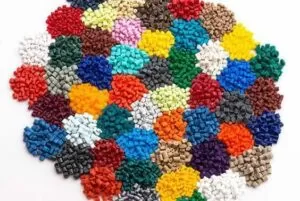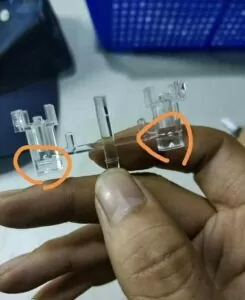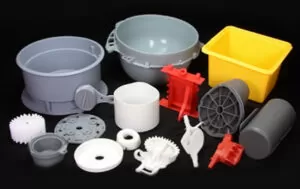Introduction:
Understanding Injection Molding Process
Injection molding is famous for its all-round and wide range of applications. Injection molding is a versatile manufacturing process that can be used to create products from a variety of materials.

The most common applications for injection molded parts are plastic containers, toys, pipe fittings, electrical components, telephone handsets, automotive parts, electrical and medical industries.

Right plastic material Injection molding is also used to make consumer products such as toys and toothbrushes.

An important reason for this general success is the wide variety of compatible injection molding materials, and has good heat and chemical resistance. Injection molding is compatible with a wide range of plastic materials and its products are common in every household and industry.

In this article, some of the most common plastic materials will be discussed in detail and their properties, process characteristics, and typical application areas will be summarized.

PS (Polystyrene)
PS Performance
It has a series of advantages such as hard texture, high rigidity, excellent electrical insulation, good fluidity, wide processing temperature, easy molding, easy coloring, good printability, and high transparency.

However, it also has high brittleness and poor environmental stress cracking resistance. It has shortcomings such as poor heat resistance, easy aging and yellowing, and sometimes cannot meet the requirements of actual use.

Therefore, modification of polystyrene has always been the key to the development and application of polystyrene products.
PS Process Characteristics
The melting point of PS is 166°C, and the processing temperature is generally 185-215°C. Melting temperature is 180-280℃. For flame-retardant materials, the processing temperature range is wider, with an upper limit of 250°C and a decomposition temperature of approximately 290°C.

Typical Application Range
Packaging products, disposable medical supplies, toys, cups, knives, tape reels, storm windows and many foam products.

HIPS (Modified Polystyrene)
HIPS Performance
HIPS is an improved material of PS. The molecule contains 5-15% rubber component. It is approximately 4 times tougher and has significantly higher impact strength than PS (high-impact polystyrene).

Offers flame retardant rating and resistance to stress cracking. grade, high gloss grade, ultra-high impact strength grade, glass fiber reinforced grade, low residual volatile grade, etc.

HIPS Process Characteristics
HIPS molecules contain 5-15% rubber, which affects flowability to some extent and requires higher injection pressures and mold temperatures. Since the cooling rate is slower than PS, sufficient holding pressure, holding time and cooling time are required.

General Scope
Packaging and disposable materials, especially food packaging materials and eating utensils.

SA (SAN Styrene Acrylonitrile Copolymer/Dali Adhesive)
SA Performance
SA is a hard, transparent material that is less prone to internal stress cracks. SA has strong bearing capacity, chemical reactivity resistance, thermal deformation resistance and geometric stability.

SA Process Characteristics
Runners and Gates: All conventional gates can be used. Gates must be properly sized to avoid streaks, burn spots and voids.

Typical Application Range
Electrical, daily necessities, automotive industry, household products, cosmetics packaging safety glass, water filter housings and faucet knobs.

ABS (Super Unbreakable Plastic)
Acrylonitrile Butadiene Styrene Abs Performance
ABS is synthesized from three chemical monomers: acrylonitrile, butadiene and styrene.

ABS Process Characteristics
ABS is highly hygroscopic and sensitive to moisture. Before molding, sufficient drying and preheating (at least 2 hours at 80-90°C) must be carried out and the moisture content must be controlled to 0.03% or less.

General Scope of Application
Cars, refrigerators, high-strength tools, cell phone cases, typewriter keyboards, golf carts, jet sleds and other recreational vehicles, etc.

BS (K Material)
BS Performance
BS is a butadiene-styrene copolymer, which has certain toughness and elasticity, low hardness (softness) and good transparency. BS material is easy to color, has good fluidity and is easy to form.

Characteristics of the BS Process
K material, also known as K-resin, is a styrene-butadiene copolymer (BS) with good transparency, gloss, and impact resistance. K material is an amorphous polymer with good fluidity and easy processing The finished product has a smooth appearance, gloss and high transparency.

Acrylic (Acrylic)
Performance of PMMA
PMMA is an amorphous polymer, commonly known as organic glass. It has excellent transparency, heat resistance (heat distortion temperature 98°C), and impact resistance.

The mechanical strength of the product is medium, but the surface hardness is low and it is easily scratched and left marks by hard objects.

PMMA Process Characteristics
PMMA has strict processing requirements. Very sensitive to humidity and temperature. It must be dried thoroughly before processing (recommended drying conditions are 90°C, 2-4 hours).

The melt viscosity is high and requires high temperature (225~245℃) and high pressure drying, and the mold temperature is 65~80℃.

Typical Application Range
Automotive industry, pharmaceutical industry, industrial applications, daily consumer goods.

PE (Polyethylene)
PE Performance
PE is the most produced plastic. It has the characteristics of soft, non-toxic, low price, easy to process, excellent chemical resistance, not easy to corrode, not easy to print, etc.

There are many types, the commonly used ones are LDPE (low density polyethylene) and HDPE (high density polyethylene).
PE Process Characteristics
The biggest feature of PE parts is that they have a high mold shrinkage rate, making them prone to shrinkage and deformation. PE material has low water absorption and does not need to be dried.

PE has a wide processing temperature range and is not easy to decompose (the decomposition temperature is 320°C). If the pressure is high, the density of the part will be high and the shrinkage rate will be small.
HDPE application scope: refrigerator containers, storage containers, household kitchenware, sealing covers, plastic bags,etc.

PP (Polypropylene)
PP Properties
PP is a crystalline polymer. PP is the lightest commonly used plastic, with a density of only 0.91g/cm3 (less than water).

PP is commonly known as “100% plastic” because of its high stress cracking resistance and long bending fatigue life. PP products are lightweight, durable and have excellent chemical resistance.

PP Process Characteristics
The processing temperature of PP is 220~275℃. It is better not to exceed about 275℃.

It has good thermal stability (decomposition temperature is 310℃), but at high temperature (270-300℃), it will stay in the barrel for a long time. There is a possibility of degradation.

Typical Application Range
Automotive industry, equipment, daily consumer goods.

PA (Nylon)
PA Performance
PA is also a crystalline plastic. As an engineering plastic, the molecular weight of nylon is generally 15,000-30,000, and there are many varieties. Commonly used nylon 6, nylon 66, nylon 1010, nylon 610, etc. are used in injection molding processing.

PA Process Characteristics
Since PA is easily hygroscopic, it must be thoroughly dried before processing to keep the moisture content below 0.3%.

General Scope of Application
Electronic and electrical, automotive, construction, office equipment, machinery, aerospace and other industries.

POM (Blessing)
Properties of Polyoxymethylene
Polyoxymethylene is a linear polymer with no side chains, high density and high crystallinity, with excellent comprehensive properties.

Polyformaldehyde is a hard and dense material with a smooth and shiny surface, light yellow or white, and can be used for a long time in the temperature range of -40-100°C.

POM Process Characteristics
POM does not need to be dried before processing. It is best to preheat (around 100°C) during processing, which is good for the dimensional stability of the product. The screw speed should not be too high and the residual amount should be small.

Typical Application Range
POM has a very low friction coefficient and good geometric stability, making it particularly suitable for making gears and bearings. Because it also has high temperature resistance, it is also used in pipeline components (pipeline valves, pump housings), lawn equipment, etc.

PC (Bulletproof Glue)
PC Performance
Polycarbonate is a thermoplastic resin containing -[O-R-O-CO]-links in the molecular hair chain. According to the different ester groups in the molecular structure, it can be divided into aliphatic spin, alicyclic, and aliphatic-aromatic types.

Among them, it has practical The most valuable ones are aromatic polycarbonates, and bisphenol A polycarbonate is the most important, with a molecular weight of usually 30,000-100,000.

PC Process Characteristics
PC materials must be thoroughly dried (about 120°C, 3 to 4 hours) before processing, and the moisture content must be controlled within 0.02%.

Small amounts of moisture from high-temperature processing may cause cloudiness, silver flakes, or bubbles within the product. PC has considerable strong elastic deformation capability at room temperature.

General Scope of Application
The three major application fields of PC are glass assembly industry, automobile industry and electronic and electrical industry, followed by industrial machinery parts, optical discs, civilian clothing, computers and other office equipment, medical care, theaters, entertainment and protection. Products, etc.

EVA (Rubber)
EVA Performance
Usually the so-called EVA products mainly refer to EVA resin, and its VA content is generally 5% to 40%. EVA film has the characteristics of good toughness, excellent impact resistance, high transparency, not easy to degrade, non-toxic and harmless, and low shrinkage.

Characteristics of the EVA Process
When processing EVA, pay attention that the mold temperature and material temperature are not too high. If it is too high, the surface becomes rough.

EVA products tend to stick to the front mold. The cold material hole in the main flow path of the nozzle is preferably button-shaped.

When the temperature exceeds 250℃, it decomposes easily. EVA requires the use of “low temperature, medium pressure, medium speed” process conditions to process the product.

PVC (Polyvinyl Chloride)
PVC Properties
PVC is an amorphous plastic with poor thermal stability and is susceptible to thermal decomposition. PVC is difficult to burn, has high viscosity, poor fluidity, high strength, resistance to climate change and excellent geometric stability.

PVC Process Characteristics
The mold temperature is low (20-50℃). Air streaks, black streaks, etc. are prone to occur during PVC processing. The processing temperature must be strictly controlled (processing temperature 185~205°C).

The injection pressure can reach 1500bar and the holding pressure can reach 1000bar. In order to avoid material deterioration, the corresponding injection speed should generally be used, the screw speed should be low (less than 50%), the residual amount should be small, and the back pressure should not be too high.

General Scope of Application
Water pipes, household pipes, residential wall panels, commercial machine casings, electronic product packaging, medical equipment, food packaging, etc.

PPO (Polyphenylene Ether)
PPO Performance
Polyphenylene ether is poly2,6-dimethyl-1,4-phenylene ether, also known as polyphenylene ether, and its English name is polyphene oxyol (abbreviated as PPO). Modified polyphenylene ether is modified with polymers such as polystyrene. Polyphenylene ether, MPPO for short.

PPO Process Characteristics
The appearance of pure PPO resin is transparent amber, flame retardant, extinguishes immediately after leaving the fire, has a bright flame with thick black smoke, and emits a floral and fruity smell.

Pure PPO is a poorly processed plastic, so it is basically impossible to put it into large-scale industrial production without modification. Only modified PPO can be put into large-scale industrial production. This is the so-called MPPO, which has excellent comprehensive properties.

PPO and MPPO are mainly used in electronic equipment, automobiles, home appliances, office equipment, industrial machinery, etc.

Performance of PBT
PBT (polybutylene terephthalate fiber) has the weather resistance, dimensional stability, wrinkle resistance and other characteristics of polyester; it also has the soft feel and wear resistance of nylon; its elastic recovery is better than nylon, and its dyeing performance is better than polyester. Normal pressure boiling dyeing.

PBT Process Characteristics
Drying process: This material is easily hydrolyzed at high temperatures, so drying before processing is very important. Humidity must be less than 0.03%.

Conclusion
Injection molding is a versatile production process with many advantages. Injection molded parts are strong, lightweight, and can be made from a variety of materials. Injection molding is also a fast and efficient production process that can be used to create large quantities of parts.

The materials used in plastic injection molding generally depend on the use of the product. Commonly injection molding material selection include ABS, PC, LCP, nylon, PE, PET, PEI, LDPE,TPU( thermoplastic polyurethane) ,TPE(thermoplastic rubber ) ,HDPE and PP.

These injection molding resins materials are used in a wide range of products from medical devices to electronic components. In short, plastic injection molding is a versatile manufacturing process that can be used to create products from a variety of materials.

The most common applications for injection molded parts are plastic containers, toys, pipe fittings, electrical components, telephone handsets, automotive parts, electrical and medical industries.






